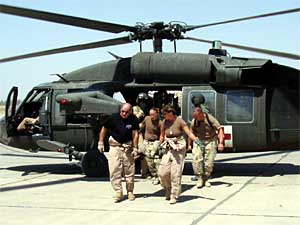Audio
Photos
More from MPR
Your Voice
| |||||||||||||||||||||||||||||||||||
U.S. soldier injuries mount in Iraq
September 14, 2003
Much of the news about the war on Iraq has focused on the death toll of U.S. soldiers, especially the number of deaths since President Bush declared the end of major combat in early May. The Defense Department says as of Sept. 17, 185 U.S. troops have died from combat wounds since the war with Iraq began. The seriously wounded get less attention, even though they significantly outnumber the dead. Caught up in sniper fire, and targeted by homemade bombs and rocket-propelled grenade attacks, troops are losing arms, legs and eyes.
St. Paul, Minn. — When two Army officers arrived at Judy Deutsch's home at 6:30 the Saturday morning of Labor Day weekend, the New Prague woman feared the worst.
"It was a little terrifying at first, but I have to say they handled everything perfectly," Deutsch recalls. "The first words out of her mouth were, 'You need to know he's going to be OK.'"
 | |||
The day before, Keith Deutsch, 20, the third of Judy Deutsch's five children, lost his right leg in a guerrilla-style attack of the type U.S. troops are facing regularly in Iraq.
"You know what? It was just like everything we've always heard on the news," Deutsch says. "An RPG -- a rocket propelled grenade -- hit the Army vehicle he was traveling in. He was in the rear vehicle of a convoy."
Barely a week later, Deutsch was with her son at Walter Reed Medical Center in Washington, D.C.
She says Keith's in a lot pain but that he's recovering well. It's too early to begin fitting him with a prosthetic leg. Serious wounds above his amputation must heal first.
"He talks about what lies ahead. He's scared about, you know, getting to college and doing what he wanted to do," Deutsch says.
 | |||
Keith's mom says he joined the Army Reserve right out of high school to earn money for college.
"He wants to become a civil engineer, or did. And he was going to use Army funds to do that, to go to college. Now his major concern is any of the benefits that the Army will offer him," she says.
Air Force reserve physician, Maj. Gene Delaune was the last doctor to see Keith Deutsch in Iraq.
Speaking from the sprawling U.S. base at the what used to be Saddam Hussein Airport in Baghdad, Delaune said he's seen a lot of cases like Keith's -- irreparable damage to soldiers' arms and legs.
"The vast majority of what we see are people who are either attacked with RPGs, which are rocket-propelled grenades, or something they call IEDs -- improvised explosive devices," Delaune says. "The injuries they cause tend to be very similar. Everyone -- when they are out in the city -- everyone has to wear a flak jacket, so we see very few trunk injuries."
 | |||
Until the middle of the summer, Dr. Delaune, 38, was living comfortably with his wife in Washington, D.C. He works as an emergency physician and instructor at George Washington University. Now on active duty, Delaune now helps airlift wounded troops out of Baghdad for hospitalization in places like Germany, and back home in the United States.
Since arriving in Baghdad July 16, virtually every injured soldier Delaune has seen was hurt seriously enough in that part of the country to require transport out.
"We see a lot of amputations," Delaune says. "Initially I was probably seeing one or two amputations a day. Now we're down to maybe one every two or three days," says Delaune. "The limbs just get damaged to a point where they can't be salvaged, and in the field hospitals where they're initially treated, an amputation is performed. We see a lot of eye injuries as well."
Delaune says he's become numb to war scenes which were initially surreal -- helicopters bringing in bloody wounded soldiers; enemy mortar fire exploding near the base. What's struck him most, he says, are the devastating, permanent wounds he's been seeing over and over on soliders, many of them fresh out of high school.
 | |||
"They come here 19, 20 years old and when I see them leaving, missing limbs -- I've seen up to three limbs gone off people, and I don't think in our generation we've seen this amount of harm done to young people," Delaune says.
Although injury and death numbers from the current war with Iraq are only a tiny fraction of those suffered during the Vietnam war, not since Vietnam have U.S. troops been hit with so many casualties.
According to U.S. Central Command 1,251 troops have been wounded in action in Iraq since the onset of hostilities in late March. More than half of the injuries, 699, occurred after May 1, when President Bush declared major combat over.
Fewer than 500 U.S. troops were wounded in action during the first Gulf War in the early 1990s.
Dr. Delaune says a stream of injured troops continues to flow through his facility. But he says, at least in the Baghdad area, the numbers appear to be declining. He estimates more than half the soldiers he's helping to airlift out now have medical problems that have nothing to do with combat.
 | |||
"When I first got here, we were probably seeing about 30 or 40 a day," Delaune says. "Now we're probably down to an average of 20 a day."
According to the Department of Defense, through late August, almost all of the soldiers wounded in action were men and most of them white. Seven in 10 were age 30 and under. Nearly half were younger than 25, including 19-year-old Michelle Loftus.
Loftus, who grew up on a farm outside of Rochester, suffered severe facial injuries in late July, when a homemade bomb exploded near the Humvee in which she was traveling in Baghdad. The bandages over her mouth are gone now, but not all of the damage has been repaired.
"I'm looking at about two surgeries, one for the bone graft, and they're going to do some small plastic surgery just to dress up the scars and the wounds. Then after that, it'll go back to getting implants for the teeth that I'm missing," Loftus says.
Loftus says soldiers still in Iraq tell her it's about as dangerous there now as it was when she was hurt a month and a half ago.
 | |||
"Once you're outside the gates of the camps, then the threat level is hostile. But at the same time it's ... just kind of a chance by chance thing," Loftus says. "It's just kind of been small hit-and-run type of attacks."
Dr. Delaune says when he and others at the Baghdad base watch CNN, they're sometimes shocked at how little coverage there is about the war in Iraq.
"When I write back to friends at home and family, they're shocked that I'm still seeing people that are as messed up as I'm seeing," Delaune says. "To be fair to these guys who are getting hurt, people should know that they're still coming at a pretty significant rate back to the U.S., and they're going to be around. So the war's over but people are still getting hurt, and just don't forget about that."
|
News Headlines
|
Related Subjects
|


